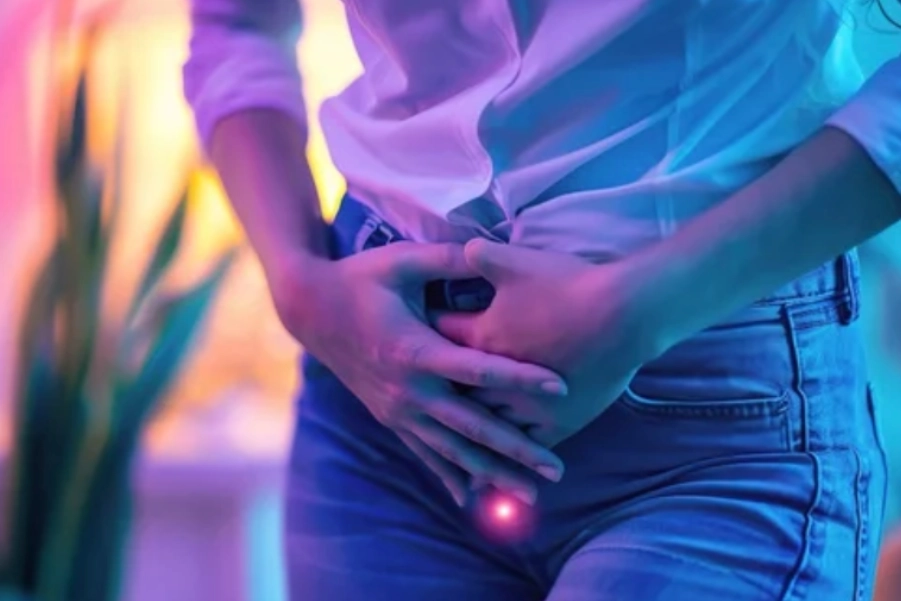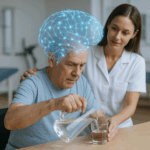1. Overview of Condition:
Urinary urgency and frequency (UUF) are common symptoms of pelvic floor muscle dysfunction (PFMD), often leading to involuntary urine loss, known as urgency incontinence. Women with these symptoms frequently experience a strong, urgent need to urinate, often with little warning, resulting in accidents if not properly managed. The causes of UUF can include overactive bladder (OAB), pelvic floor muscle dysfunction (either hyperactivity or weakness), or bladder irritability. UUF may also be linked to anxiety, stress, or neurological conditions, though it is commonly associated with dysfunction in the pelvic floor muscles and bladder coordination.
Symptoms:
- Frequent urination (more than 8 times per day)
- Sudden, intense urge to urinate with difficulty postponing urination
- Involuntary leakage associated with urgency (urgency incontinence)
- Waking up multiple times at night to urinate (nocturia)
- Difficulty controlling urination during physical exertion or stress
Probable Deficits:
- Overactivity or dysfunction of the detrusor muscle (bladder muscle), leading to premature contractions.
- Hyperactivity or poor coordination of the pelvic floor muscles, preventing them from properly supporting bladder control.
- Reduced bladder capacity due to irritation or incomplete bladder emptying.
- Insufficient relaxation of the pelvic floor muscles during bladder filling or voiding.
2. Assessment and Evaluation of Impairment:
An effective assessment should identify the root cause of urinary urgency and frequency symptoms, focusing on the pelvic floor muscles, bladder function, or other contributing factors.
Clinical Tools for Assessment:
- Patient History: Collect detailed information about urination frequency, nocturia, urgency episodes, and any incontinence. Document a history of bladder irritants (e.g., caffeine, alcohol, spicy foods).
- Bladder Diary: A record of the patient’s voiding patterns, including urine volume, times of urination, and incidences of urgency or incontinence, helping identify patterns and triggers.
- Urinary Incontinence Questionnaire (e.g., ICIQ-UI): Used to assess the severity and impact of symptoms on daily life.
- Pelvic Floor Muscle Assessment:
- Manual Muscle Testing (MMT): Evaluates pelvic floor muscle strength, endurance, and tone via vaginal or rectal examination.
- Perineometer or EMG Biofeedback: Measures pelvic floor muscle strength and provides real-time feedback for training.
- Urodynamics (if necessary): Evaluates bladder function, detrusor pressure, bladder compliance, and detects underlying bladder irritability or detrusor overactivity.
3. Goal Setting:
The primary goal of treatment is to reduce urinary urgency and frequency, restore pelvic floor muscle function, and improve bladder control. Secondary goals include enhancing quality of life and ensuring the patient maintains bladder control during daily activities.
Specific Goals:
- Primary: Reduce episodes of urinary urgency and frequency to within normal ranges (less than 8 voids per day) and minimize or eliminate episodes of urgency incontinence.
- Secondary:
- Improve pelvic floor muscle function (both strength and relaxation).
- Address bladder irritability by optimizing fluid intake and bladder habits.
- Reduce nocturia by improving nocturnal bladder capacity and function.
- Enhance bladder training and self-management strategies.
- Increase patient education and adherence to the rehabilitation program.
4. Recommended Interventions:
Electrotherapy:
- Pelvic Floor Electrical Stimulation (PFES): Electrical stimulation improves pelvic floor muscle function, coordination, and reduces hyperactivity of the detrusor muscle.
- Protocol: 10-20 minute sessions, 2-3 times per week, using low-frequency electrical stimulation.
- Evidence: A systematic review (Lee et al., 2022) supports PFES in reducing urgency and frequency symptoms by improving pelvic floor coordination.
Biofeedback Therapy:
- EMG Biofeedback: Used to train pelvic floor muscle relaxation and contraction. Biofeedback helps patients develop awareness of pelvic floor muscle activity, promoting proper contraction and relaxation patterns.
- Protocol: Sessions lasting 10-15 minutes, 2-3 times per week, progressively increasing intensity.
- Evidence: Studies (Bo et al., 2023) show that EMG biofeedback is effective in improving pelvic floor control, reducing urgency, and preventing accidents.
Pelvic Floor Muscle Training (PFMT):
- Relaxation and Strengthening Exercises: Exercises to enhance pelvic floor muscle strength and relaxation, focusing on reducing overactivity and increasing endurance for better bladder control.
- Protocol:
- Strengthening: 3 sets of 10-15 contractions daily, focusing on both short and long holds.
- Relaxation: Incorporate pelvic floor relaxation techniques with diaphragmatic breathing and progressive muscle relaxation.
- Evidence: A meta-analysis by Neels et al. (2024) supports the efficacy of PFMT in reducing urgency and frequency, especially when paired with other interventions like biofeedback.
- Protocol:
Bladder Training and Behavioral Modifications:
- Timed Voiding: Structured voiding schedules to help the bladder adjust to a normal voiding pattern, starting by urinating every 2-3 hours and gradually increasing intervals as tolerated.
- Protocol: Gradually extend voiding intervals by 15-minute increments until normal bladder habits are restored.
- Evidence: Research (Fitzgerald et al., 2023) suggests that bladder training significantly reduces urgency symptoms.
- Fluid Management: Encourage appropriate fluid intake to avoid bladder irritation. Advise on fluid intake of 1.5-2 liters per day while avoiding bladder irritants (e.g., caffeine, alcohol, spicy foods).
- Protocol: Ensure balanced fluid intake while avoiding excessive or insufficient consumption.
- Evidence: Studies (Wyman et al., 2022) show that fluid and dietary modifications help improve bladder symptoms.
Core and Postural Training:
- Core Stabilization Exercises: Strengthen core muscles to improve postural alignment and reduce intra-abdominal pressure that contributes to urgency.
- Protocol: Exercises like pelvic tilts, abdominal bracing, and bridging.
- Evidence: Core stabilization exercises help improve pelvic floor muscle function and reduce urgency (Schultz et al., 2023).
Breathing and Relaxation Techniques:
- Diaphragmatic Breathing: Teach patients diaphragmatic breathing to relax the pelvic floor muscles and reduce tension during urgency episodes.
- Protocol: 5-10 minutes of deep breathing, 2-3 times per day.
- Evidence: Research (Bo et al., 2024) suggests diaphragmatic breathing aids in reducing urgency.
5. Precautions and Special Considerations:
- Bladder Irritants: Caution with bladder irritants in the diet (e.g., caffeine, spicy foods) that could worsen symptoms.
- Pregnancy/Postpartum: Modify interventions to avoid discomfort, particularly for patients in early pregnancy.
- Pelvic Pain: Prioritize pelvic floor relaxation exercises to avoid exacerbating pelvic pain.
6. Reassessment, Criteria for Progression/Change in Care Plan:
- Symptom Tracking: Use bladder diaries and symptom questionnaires (e.g., ICIQ-UI) to track improvements in urgency and frequency, including nocturia.
- Functional Assessments: Reassess pelvic floor muscle function using manual muscle testing, EMG biofeedback, or perineometer readings.
- Criteria for Progression:
- Reduction in urgency and frequency, with improved bladder control and fewer episodes of incontinence.
- Improvement in pelvic floor muscle relaxation and strength.
- Successful bladder training leading to normalized voiding patterns.
Progression Plan:
- Once symptoms improve, reduce clinic visits and emphasize long-term self-management (e.g., home exercises, bladder training).
- Reassess at 3-6 months to ensure continued improvement and address relapses or new issues.
References:
- Lee, J. Y., et al. (2022). Effectiveness of Pelvic Floor Electrical Stimulation for Overactive Bladder and Urinary Urgency. Urology Journal.
- Bo, K., et al. (2023). EMG Biofeedback in Pelvic Floor Rehabilitation: A Systematic Review. Journal of Urogynecology.
- Neels, H., et al. (2024). Pelvic Floor Muscle Training for Urinary Urgency and Frequency: A Meta-analysis. International Journal of Women’s Health.
- Fitzgerald, M. P., et al. (2023). Bladder Training and Behavioral Modification for Overactive Bladder Syndrome. Journal of Clinical Urology.
- Wyman, J. F., et al. (2022). Dietary Modifications and Fluid Management for Overactive Bladder Symptoms. Neurourology and Urodynamics.
- Schultz, M., et al. (2023). Core Stabilization and Pelvic Floor Rehabilitation in Women with Urinary Symptoms. Journal of Physiotherapy Research.
Disclaimer:
The treatment options must be chosen wisely and appropriately based on the individual case. Consultation with a qualified healthcare provider is essential to determine the most suitable treatment approach. The content provided is for informational purposes only and should not be considered as medical advice.






